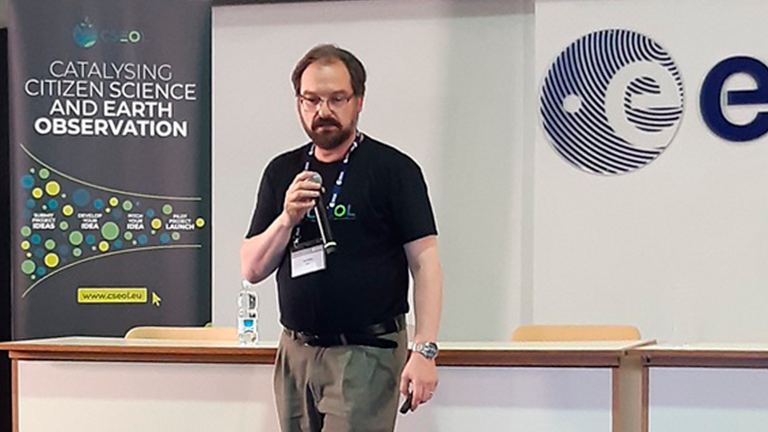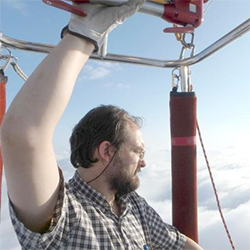
Joan Masó is a physicist who specialized in spatial information and programming. He is a researcher at CREAF and the Autonomous University of Barcelona (UAB) GRUMETS research group. At the Cos4Cloud project, his research group leads the Architecture and interoperability activities.
When asking him what interoperability is, he defines it as an essential piece to make it possible to include the eleven developed services and resources in the European Open Science Cloud (EOSC) ecosystem, as well as enable the services integration in the citizen observatories.
This way, all the citizen observatories will be able to improve their technological capacities, such as artificial intelligence species identification, data combination from sensors and photos, and camera traps improvement etc. even if they have different interfaces to process, share and store data, what are called APIs (Application Programming Interfaces).
Joan, you have a multidisciplinary background. How did you end up working in interoperability and standards in the citizen science field?
My research group started working on interoperability thanks to the Infrastructure for Spatial Information in the European Community (INSPIRE), a spatial data infrastructure which aims to facilitate public access to spatial information across Europe and enable public sector organisations to share it. We were involved in the decision-making of how INSPIRE should be. As a result of this collaboration, we start participating in the Open Geospatial Consortium (OGC), a worldwide community committed to improve access to geospatial or location information.
Later on, we started working on citizen science due to our motivation to improve citizen observatories’ technical capacity to gather, store and exchange citizen science data. Our experience began with Fenodato, a project in which we encourage citizens to report on phenological events.

Since then, we have never stopped working on citizen science projects! My research group also has participated in GroundTruth 2.0, WeObserve and in the CSEOL PhenoTandem, which was recently finalized, and now in Cos4Cloud.
‘Interoperability’ can be a tricky word to understand for non-technical people. How would you explain this concept?
When I explain what it is, I like to use the silo parallelism. A silo is a structure to store bulk materials. Now, suppose that you have many different silos that, instead of physical materials, store data. The problem with that is that this information is locked there; you can’t exchange it or establish communication among different silos.
In the citizen science field, these ‘silos’ represent the citizen observatories (COs), which are the infrastructures that agglutinate a considerable amount of citizen science data. Nevertheless, most of the time, you can’t reuse, share, or integrate the data between different COs.
For example, if a citizen observatory stops working, we may lose all of this data! In this context, what interoperability does is find a ‘common language’ that makes connecting the COs possible.
So, when we talk about ‘interoperability’ and standards in citizen science, we are looking for a kind of adapter whose main objective is to connect citizen science platforms and tools…Why is it so crucial to Cos4Cloud?
Yes, it is. Specifically, in the Cos4Cloud project, I consider that my research group and I are architects, because our objective is to build connections among citizen observatories, services, and the EOSC. So that, even if they are different, they are also part of a single architecture that can establish connections.
In more detail: we are developing eleven technological services to improve citizen science platforms. Still, we need to be able to integrate these tools in the diverse citizen observatories, which work with different APIs languages. On the other hand, we will include these services and resources in the EOSC, which also works with a different set of rules. Interoperability is an essential piece to find precisely this ‘common language’ so that it is possible to reuse, share or integrate the data and tools between all these components.

How are you building this common ‘architecture’, in which stage of the process are you?
Currently, we’re discussing and deciding how to do it. Consensus among the developers is the essence of enabling interoperability so regular discussions should happen to reach consensus. One of the options is that all the citizen observatories ‘speak’ the same language, but this isn’t easy because they are all mature infrastructures with their own APIs. Also, we can try to build adapters that enable us to establish communications channels, and this option is more feasible.
To decide the methodology we will adopt, we participate in regular Open Geospatial Consortium meetings, where we present and discuss our ideas to find what we call ‘interoperability arrangements’. Also, we are organizing practical Hackathons where developers meet and the proposed approaches are tested and with all the Cos4Cloud partners involved in the technical part of the project.
What do you think Cos4Cloud will bring to the current citizen science context?
I identify two clear points.

Integrating the Cos4Cloud services in the EOSC means that the citizen science data will be at the same level as other scientific data. This will contribute to tackling one of citizen science’s challenges: the scientific and government sectors’ lack of trust in the citizen science data.
On the other hand, the services we develop will help create new citizen observatories apps and increase the technological capacity of the ones that are already functioning. As I said, the idea is that these tools are interoperable and available to all citizen observatories, even if they have different APIs.
When talking about citizen science challenges and opportunities, what comes to your mind?
From my perspective, citizen science has existed since several years ago; however, the technology evolving has allowed building friendly mobile apps to report all kinds of citizen science data: biodiversity, air and quality, smells, and almost everything! And the most important thing: having fun while participating! Also, digital media, such as social media, websites, etc., facilitates citizen science communities’ creation and helps to keep them motivated and engaged in your project.
Recently Joan Masó included MiraMon’s tool, NiMMbus developed by the research group GRUMETS at the Autonomous University of Barcelona, in the EOSC portal, within the framework of the NextGEOSS project. According to Joan ‘the next step is to make available the services we’re developing in the Cos4Cloud project. And I’m sure all our work will contribute to professionalize and improve citizen observatories in particular, and science in general!’

















